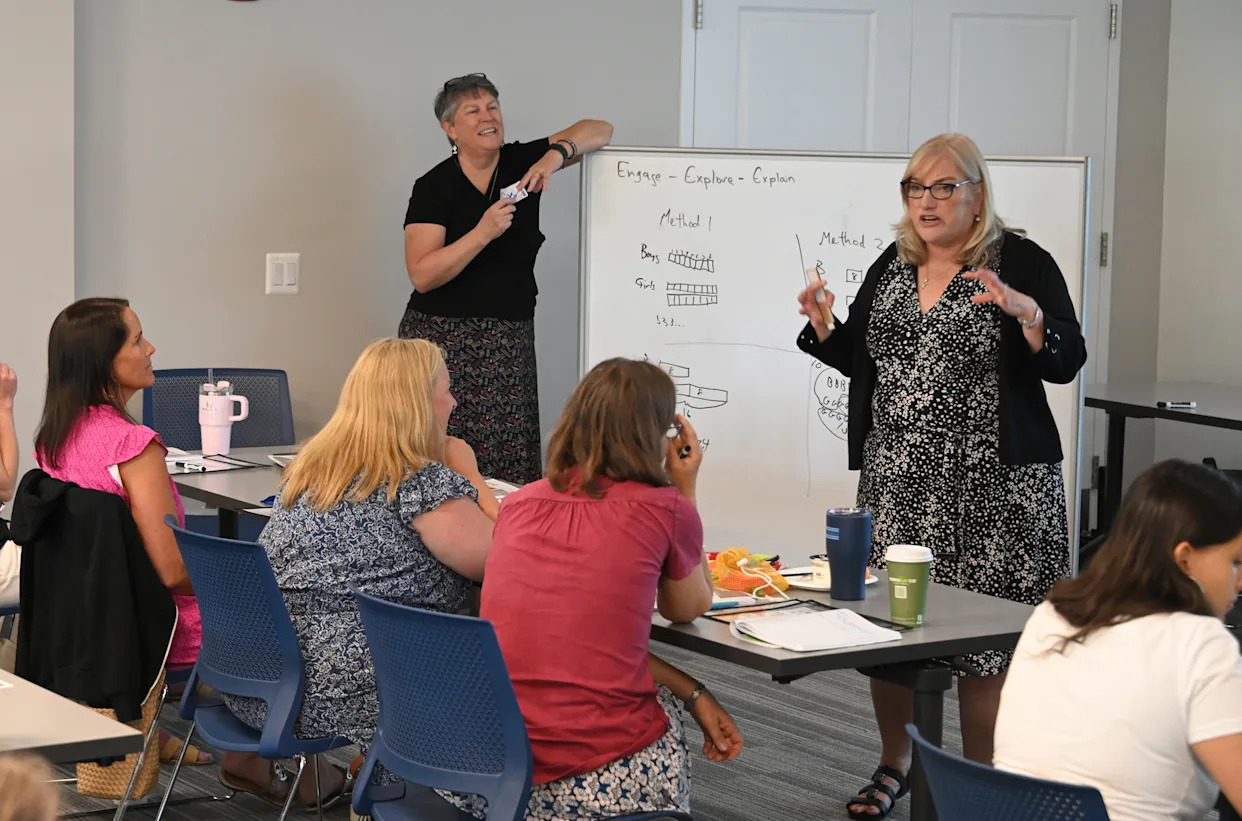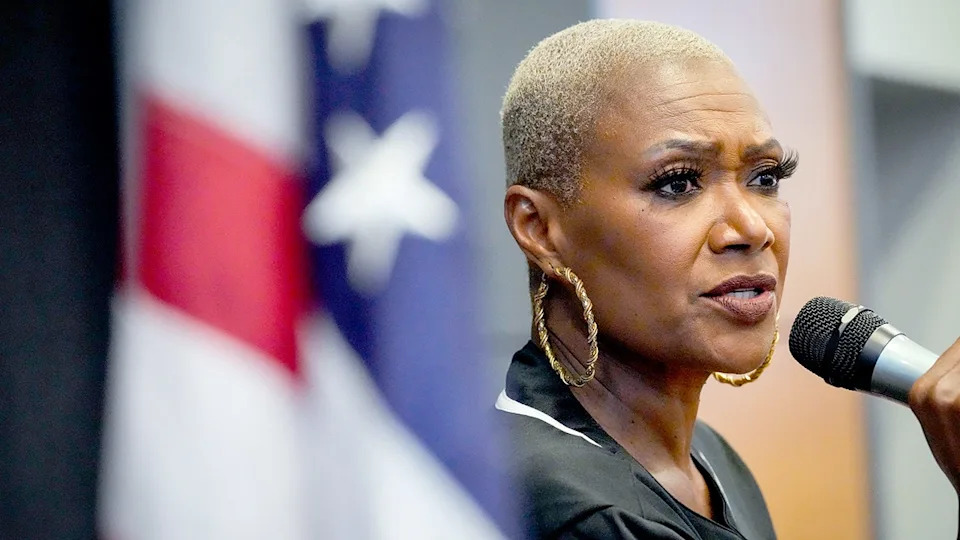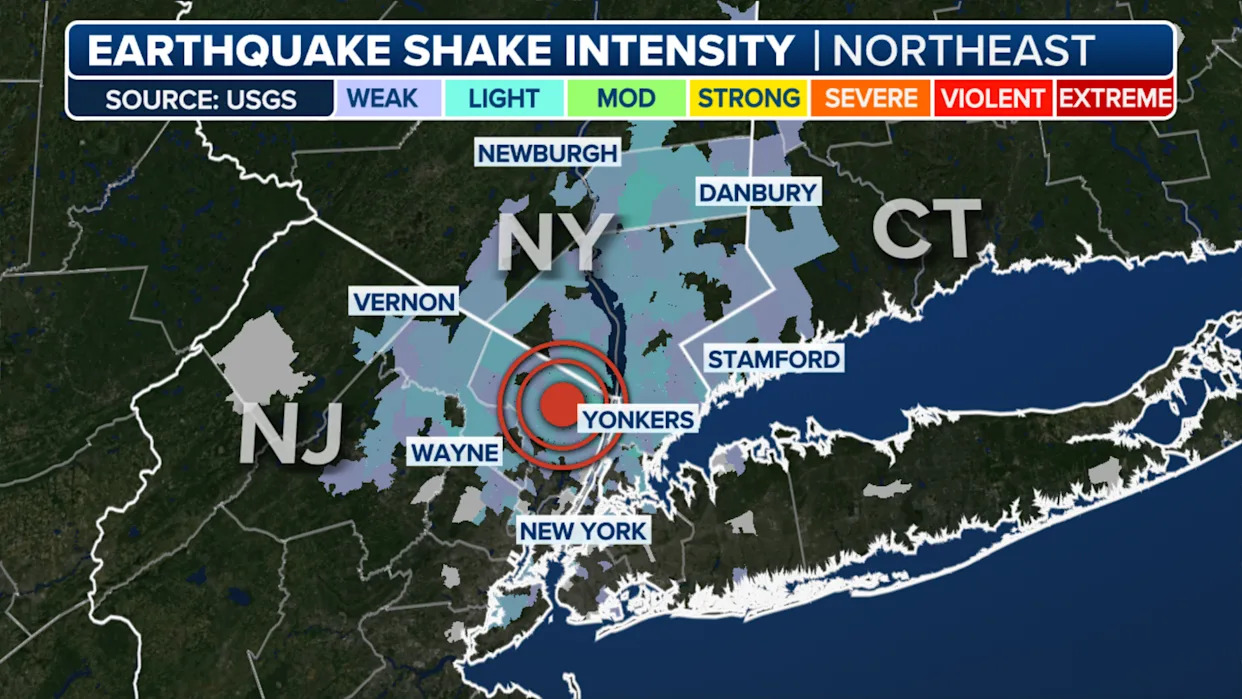
Imagine you’re a character in a math problem. You have three platters, but two cakes. All three platters need to have the same amount of cake. How would you split it?
Without even saying the word “divide,” a group of about 20 teachers from private schools spanning Pennsylvania, Maryland and Virginia, stacked cubes and folded notecards to find solutions. The answer? Two-thirds of cake per platter. But the problem doesn’t end there.
During this training in “Singapore math” — teaching methods and curricula developed in Singapore, which has consistently led the world in student math performance — Math Champions founder Cassy Turner then asked the teachers explain why they did what they did, before moving on to the next question.
Owings Mills K-12 girls’ school, Garrison Forest School, hosted the two-day public workshop last week on this style of teaching math. After seeing success adopting Singapore math for its lower school over the past two years, Garrison is expanding the curriculum through eighth grade this year.
Other Maryland schools — private, charter and public — have also incorporated the teaching style into their curricula in the hopes of emulating Singapore’s three decades of success.
Singapore math was developed by that Southeast Asian country’s Ministry of Education decades ago. It is a teaching style that avoids rote memorization and focuses on a slower learning approach to teach mathematical concepts, allowing students to understand them in greater detail.
At the kindergarten level, that means not introducing the plus or minus symbols until the end of the year, U.S. Singapore math textbook consultant Susan Resnick said. Instead, students can spend their time telling stories with numbers to decode the relationship between them. For example, after looking at a picture, a student might say, “There are four boys in the picture and one girl. Four and one make five.”
Research has found that students learn math best when mixing in physical objects like counting chips and blocks with drawings and in-depth discussion, said Pat Campbell, retired professor emerita at the University of Maryland’s Center for Mathematics Education. Singapore math teaches concepts beginning with concrete materials, then progresses to pictures and then brings students to abstract symbols like the plus or minus sign.
Older children’s class discussions go over three or four different methods the students used to solve a problem, always ending on the one closest to the day’s goal, Turner said.
Singapore math’s portrayal of numerical relationships is particularly “clever,” especially in how it uses drawn bars to help students visualize relationships, Campbell said.
Memorization doesn’t work well
On international measures of math performance, Singapore has consistently been a top scorer since the mid-1990s. Seeing those high scores spurred American textbook publishers to localize Singaporean math materials for U.S. classrooms, according to Campbell.
But at the core of Singapore math is problem-solving, Resnick said.
“Where we grew up, maybe thinking that calculation was the goal of mathematics … they teach calculation as a support to get to problem-solving,” she said.
Singapore teaches students starting with attitudes and thought processes, Resnick explained to the teachers, whereas American math education usually gets bogged down in the skills and concepts.
Developing a conceptual understanding of math from the ground up isn’t unique to Singapore math — it’s “something that people in math education have been espousing for many years, but it requires professional development on the part of teachers,” Campbell said.
Contrast Singapore math with what Campbell called “a show-and-tell model” of math instruction “where somebody shows you how to solve a problem and you practice doing it over and over and over again, with a reliance on memory.”
“We actually know that doesn’t work very well if you look at the product of kids’ achievement,” she said.
Getting American kids to love math
By fourth grade, Turner said, kids know if they like math or not. They’re more aware of their peers and can get embarrassed by their answers.
“They won’t ask questions, they won’t raise their hand, and so they fall further and further behind,” she said. But Singapore math can make the subject students’ third favorite behind P.E. and lunch, Turner said.
At Garrison, all three divisions previously used a different textbook program. Extending Singapore math through middle school means students only have to transition to upper school math, said Sydney Carter, the middle school’s dean and a sixth-grade math teacher.
Strategies, like drawing bar models that students learn early on, can be used to scaffold on more advanced concepts like ratios, Carter said. “That helps them feel like, ‘Oh, I can access this sort of.’”
That confidence is translating to results for Garrison’s students. The majority of K-5 students showed more than a year’s worth of growth in math on Measures of Academic Progress assessments taken last school year, according to Shannon Schmidt, director of Garrison’s Boyce Center for Learning and Thriving.
Top scores for Singapore’s students
The 2022 Programme for International Student Assessment (PISA), which tests 15-year-olds, showed “some 41% of students in Singapore were top performers in mathematics.” The United States had 7% top performers in math.
Even taking top performers out of the equation, Singaporean students still had an edge over their American counterparts: 92% of Singaporean students attained at least Level 2 proficiency in mathematics; the U.S. has 66% reaching at least Level 2.
The trend holds for younger students too. On the 2023 Trends in International Mathematics and Science Study, which tests fourth- and eighth-graders in those subjects, Singapore had international top scores for both grades, while the U.S. had around average scores at both levels.
But Singaporean students are also highly creative. On the 2022 PISA creative thinking assessment, 58% of 15-year-olds were considered top performers on the evaluation, more than 30 percentage points above the average for the 38 countries in the Organisation for Economic Co-operation and Development. The U.S. did not participate in the creativity assessment.
The difference in math instruction isn’t the only difference between the two countries’ education systems, though. Singapore has a national math curriculum. The government produces the educational materials. All teachers across the country teach the same math concepts the same way, Campbell explained.
In the United States, by contrast, student-teachers rarely get intensive instruction on how to teach math. Throughout her experience training teachers across the country, Resnick said it’s typical for student-teachers without advanced degrees in math to get one class in math education and four or five in reading.
“We don’t teach our elementary teachers how to teach mathematics. We just don’t, and that’s why it’s necessary for people to have outside … professional development around the teaching method,” Resnick said.
Varied methods in the U.S.
Additionally, U.S., state, and local jurisdictions, as well as individual teachers, have far greater control over curriculum and teaching methods than they do in Singapore, Campbell said.
Although some math curricula in Maryland do emphasize the concrete models and strategy discussions, Campbell said, the professional development teachers receive and the instructional models they use vary.
Howard and Montgomery counties support students’ conceptual understanding of math, she said. Howard County had the state’s highest percentage of students proficient in math for the 2023-2024 school year, as measured by MCAP scores: 41.1%. Montgomery County came in fourth with 33.4%.
The state adopted new math standards Tuesday. The update follows Maryland’s adoption of Common Core Standards in 2010 and the updated College and Career Readiness Standards in 2013 and 2014.
All school districts are required to align their curriculum to the College and Career Readiness math standards, Cherie Duvall-Jones, spokesperson for the Maryland State Department of Education, said when asked if a public school district could use a Singapore math curriculum.
“If you really want to address student achievement across schools, you need to have the school as the unit of change. All the teachers have to be essentially in the same approach to teaching mathematics,” Campbell said.
“Everybody can be good at math. It’s a matter of how you’re taught.”
Have a news tip? Contact Racquel Bazos at [email protected], 443-813-0770 or on X as @rzbworks.








Comments